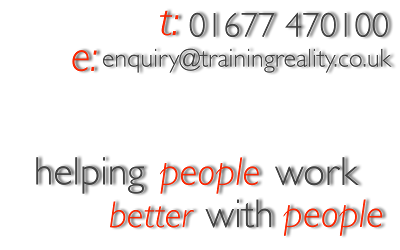Please press (at least!) one of these.
It costs you nothing, and (possibly) helps us spread the word!
Presentation skill #1 - Enthusiasm
Wednesday, 30 September 2009
Do a quick search on Google for “presentation skills” (no quotes) and you are faced with over 18 million results. Be slightly more specific (“presentation skills training”), and the results - rather bizarrely to me - jump to 30.7 million. I’d like to narrow it down to one.
Enthusiasm.
In later blogs, I’m going to delve into presentation skills in much more detail, but I’m scaling up here, and looking for the absolutely critical things that make a genuinely inspiring and effective presentation. There is much to be said about body language, tonality, structure, appearance, visual aids, delivery style, eye contact, repetition, story-telling, and so on, all of which can add enormous value, but, I believe, without enthusiasm, it means nothing.
I recently had the opportunity to go with a school group to Harewood House, north of Leeds, and whilst there, visit the Yorkshire Planetarium. The lady who gave the talk (Mojo - a pretty unforgettable name) presented really well, and kept an age range of 4-50+ engaged throughout...a pretty tough call. So, how did she do it?
Well, she had great visual aids (the projection of the stars and planets), but the presentation was pretty much delivered in the dark, so her body language, appearance, eye contact and so on were pretty irrelevant. What she did have, and what led me to believe it was going to be good before she even started, was bags of enthusiasm, which she happily shared. Astronomy is her passion, and every part of her - her tonality, body language, and the words she used - expressed this in spades. You couldn’t avoid noticing that she was excited to be there, and it was infectious.
So how do we ensure that we succeed in our presentations in the way that she did? The primary thing is to actually, genuinely, be excited about your material. If you think your presentation is dull, the chances are everyone else will do as well. Your first step, before any preparation or planning, is to ask yourself “why am I doing this?” It might be a fantastic new product or upgrade, a set of awesome business results, an exciting strategic plan, or an innovative new opportunity. If so, great, because those are the (relatively) easy ones.
The real challenge lies in those things that we might think of as more mundane, or, even worse, bad news for the audience. Dealing with those in turn:
Presenting the mundane
The big questions that arise here are (1) if it is so mundane, why is it being presented at all; and (2) are you assuming it’s mundane and therefore sharing that feeling with others.
This area came to my attention recently whilst watching Steve Jobs present the latest iPhone upgrade. When I saw him do the initial launch, I was amazed, and wanted to get one straight away. Despite some non-traditional presentation skills, here was a man so excited, so passionate about a product that it was almost impossible not to be taken along for the ride with him. I was more sceptical about the latest upgrade though...on paper, the changes seemed so much less significant than the launch that I was put in mind of a new washing powder fragrance or a recipe change for a chocolate bar. However, he believed in its significance, and put it in the context of a tremendous journey, and that it what got me involved again.
Presenting “bad news”
“Bad news” does have to be presented sometimes - poor financial results, redundancies, closures, and many other things. There might be the temptation to “overdo” the positive, leading to distrust and cynicism, but it is still possible to avoid this whilst still giving your audience a reason to listen and buy in to what you are saying.
The real fundamental here is to understand the past, acknowledge the present, but look to the future, and how that can be better than the present. My last blog entry (here) looked at the power of failure for good, and at times like these, that is more critical than ever.
--
Underlying the ability to have both the “mundane” and the “bad news” being presented well is a belief in the future, in what is being said, and a passion to make things work better and better, everyday. As a presenter, you need to have an over-endowment of this enthusiasm, to ensure that you have more than enough to share with your entire audience. Without that, all the tips, tricks and techniques in the world won’t help.
Please press (at least!) one of these.
It costs you nothing, and (possibly) helps us spread the word!





